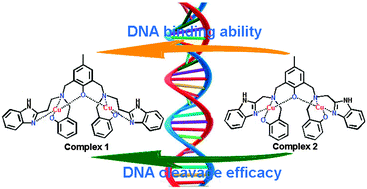Oxidative DNA cleavage promoted by two phenolate-bridged binuclear copper(ii) complexes†
Abstract
Two copper(II) complexes, [Cu2II(L1-3H)Cl] (1) and [Cu2II(L2-3H)Cl] (2), have been synthesized using two phenolate-bridged binucleating ligands, 2,6-bis{[(2-hydroxybenzyl)(2-benzimidazolylethyl)amino]methyl}-4-methylphenol (L1) and 2,6-bis{[(2-hydroxybenzyl)(2-benzimidazolylmethyl)amino]methyl}-4-methylphenol (L2). The complexes have been characterized by elemental analysis, electrospray ionization mass spectrometry, and IR spectroscopy. The DNA binding properties of the complexes have been investigated under physiological conditions by using UV-vis absorption, fluorescence, and circular dichroism (CD). The experimental results suggest that complexes 1 and 2 could strongly bind to calf thymus DNA (CT-DNA) and induce a remarkable conformational variation of DNA. And DNA binding affinity of 1 is slightly higher than that of 2, whose binding constants (Kb) are 1.85 (±0.02) × 105 M−1 and 1.51 (±0.01) × 105 M−1, respectively. Agarose gel electrophoresis revealed that both the complexes could efficiently cleave the supercoiled pUC19 plasmid DNA into its nicked and linear forms in the presence of excessive ascorbic acid (Vc) under nearly physiological conditions. However, their mononuclear analogues, [CuII(L1a-1H)Cl] (3) and [CuII(L2a-1H)Cl] (4), could not exhibit DNA cleavage activity under the same conditions, suggesting a synergistic effect of the Cu2+ centers in 1 or 2. And the DNA cleavage efficacy of 1 is superior to 2, which is consistent with their DNA binding ability. Mechanistic studies demonstrated that diffusible ˙OH, H2O2, and 1O2 are not the effective reactive oxygen species (ROS) in the cleavage process mediated by the complexes and the copper–oxo species might be responsible for the cleavage.


 Please wait while we load your content...
Please wait while we load your content...